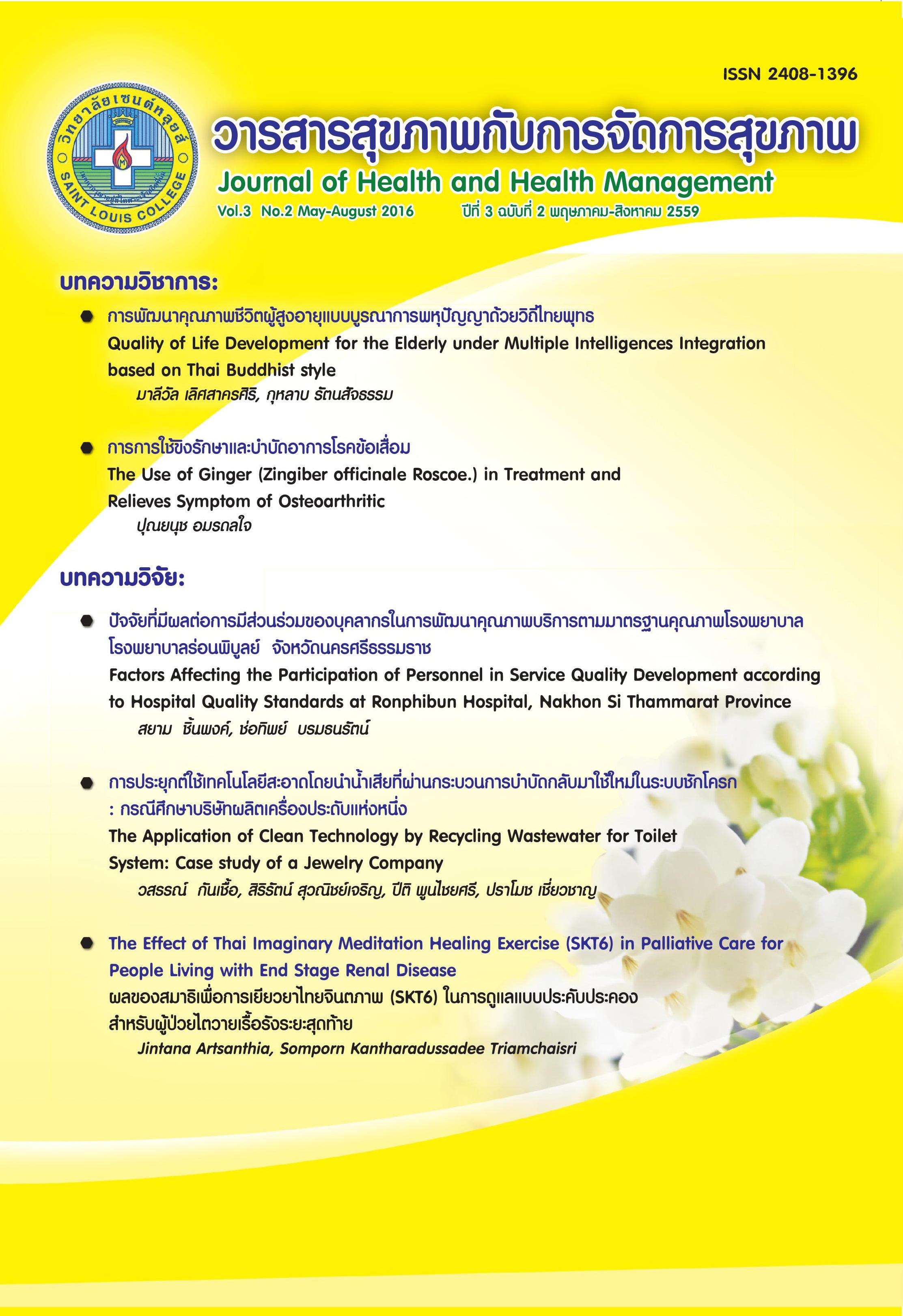The Effect of Thai Imaginary Meditation Healing Exercise (SKT6) in Palliative Care for People Living with End Stage Renal Disease
Keywords:
ESRD, palliative care, Thai imaginary meditation healing exercise (SKT6)Abstract
Chronic illnesses can pose a profound burden on the lives and families of those affected. This is particularly evident in those who have to undertake hemodialysis or peritoneal dialysis. The objective of this study was to evaluate the effect of Thai imaginary meditation healing exercise (SKT6) on quality of life of people living with end stage renal disease (ESRD). The quasi-experimental study recruited 74 people living with ESRD, divided in 2 groups: 35 people in the SKT intervention group and 39 people of the non SKT control group. The two groups were treated with hemodialysis, but was separated wards at the same hospital. In the SKT group, they practiced Thai imaginary meditation healing exercise (SKT6) during hemodialysis in hospital and home. Both groups completed questionnaires of the Edmonton Symptom Assessment System (ESAS) tool for symptom assessment and Ferrans and Powers; Dialysis version III quality of life tool. The results of the SKT6 group after the Thai imaginary meditation intervention revealed an increase of total quality of life score from a mean score of 19.65 before the intervention to a mean score of 19.98 after SKT6 intervention. The mean score of 4 dimensions of quality of life in health and functioning also increased from 17.58 to 21.28. The mean score of social and economic increased from 19.79 to 21.82. The mean score of psychological and spiritual scale increased from 21.34 to 23.88, the mean score of family scale increased from 22.85 to 24.43. In contrast, the non-SKT control group scores had an opposite pattern, with an increase in physical symptoms and uncertainty and a decrease in quality of life from time to time. We therefore suggest that the Thai imaginary meditation healing exercise (SKT6) can be a component of palliative care. The exercise combined with meditation and visualization for releasing tension and attaining spiritual fulfillment, and improving the quality of life.
References
Ferrans, C., & Powers, M. (1985). Quality of life index: development and psychometric properties. Advances in Nursing Science, 8,pp.15-24.
Gilbertson, D. T., Liu, J., Xue, J. L., Louis, T. A., Solid, C. A., Ebben, J. P., & Collins, A. J. (2005). Projecting the number of patients with end-stage renal disease in the United States to the Year 2015. Journal of the American Society of Nephrology, 16(12), pp. 3736-3741.
Hofmann, S.G., Sawyer, A.T., Witt, A.A., & Oh, D. (2010). The Effect of Mindfulness-Based Therapy on anxiety and depression: A Meta-analytic review. Journal Consult Clin Psychol, 78(2), pp. 169–183. doi: 10. 1037/a0018555.
Kantraradusadee, T.S. (Ed.). (2008). Mindfulness meditation SKT technique (Right) (7th ed.), Bangkok, TH: Samjarean Press.
Moss, A.H. (2010). Palliative care for the ESRD Patient [PowerPoint]. Retrieved from http:// www.kidneyeol.org Robert Ader, Founder of Psychoneuroimmunology, Dies. (2011). Retrieved from https://www. urmc.rochester.edu/news/story/3370/ robert-ader-founder-of-psychoneuroimmunology- dies.aspx
Robinson, L., & Stacy, R. (1994). Palliative care in the community: setting practice guidelines for primary care teams. British Journal of General Practice, 44(387), pp. 461-464.
Rogers, C., Keller, C., & Larkey, L. K. (2010). Perceived benefits of meditative movement in older adults. Geriatric Nursing, 31(1), pp. 37-51.
Triamchaisri, S. K., Mawn, B. E., & Artsanthia, J. (2013). Development of a Home-Based Palliative Care Model for people living with end-stage renal disease. Journal of Hospice & Palliative Nursing, 15(4), pp. E1-E11.
Valderrábano, F., Jofre, R., & López-Gómez, J. M. (2001). Quality of life in end-stage renal disease patients. American Journal of Kidney Diseases, 38(3), pp. 443-464.
Wowchuk, S. M., Wilson, E. A., Embleton, L., Garcia, M., Harlos, M., & Chochinov, H. M. (2009). The palliative medication kit: An effective way of extending care in the home for patients nearing death. Journal of Palliative Medicine, 12(9), 797-803.
World health organization. (Ed.) (2007). Palliative care: cancer control knowledge into action. Geneva, Switzerland: WHO Press.
Zhang, Q.L., & Rothenbacher, D. (2008). Prevalence of chronic kidney disease in populationbased studies: Systematic review. BMC Public Health, 8(1), p. 117.
Zucker, I., Yosipovitch, G., David, M., Gafter, U., & Boner, G. (2003). Prevalence and characterization of uremic pruritus in patients undergoing hemodialysis: uremic pruritus is still a major problem for patients with end-stage renal disease. Journal of the American Academy of Dermatology, 49(5), pp. 842-846.




